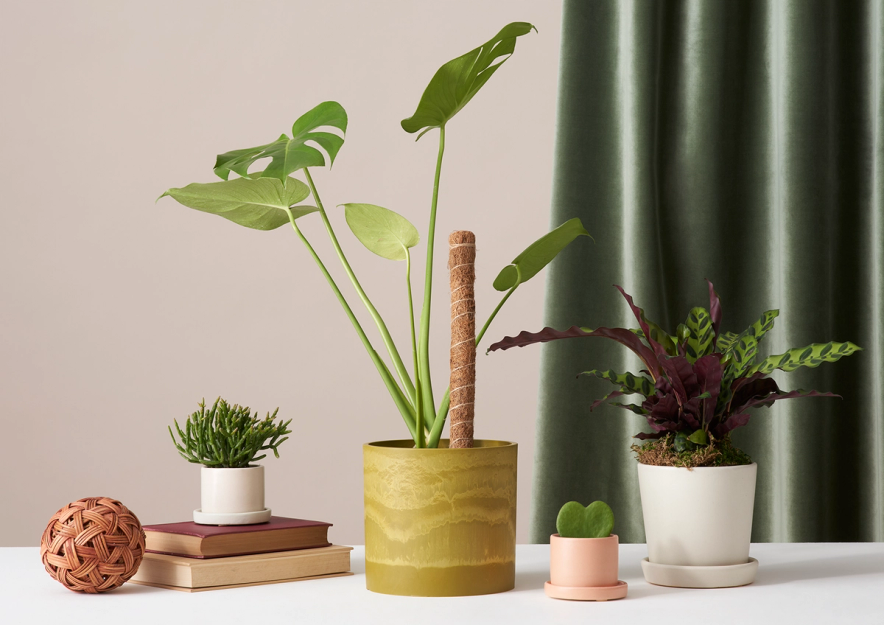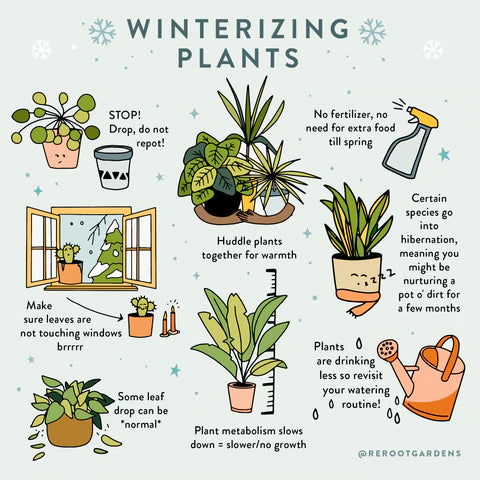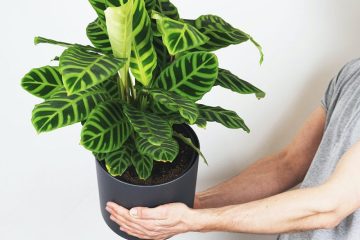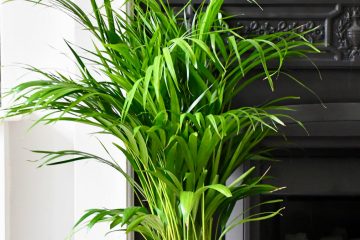Indoor plant care during winter requires adjusting watering schedules and ensuring adequate light. Keep plants away from drafts and heat sources.
Winter can be a magical season, transforming our surroundings into a snowy wonderland. However, as the temperatures drop and daylight dwindles, our beloved indoor plants face a challenging period. Just as we adapt our routines to cope with the winter chill, our green companions need special care to stay healthy and vibrant. From fending off dry air and limited sunlight to managing fluctuating temperatures, winter brings a unique set of hurdles for indoor gardening enthusiasts.
But fear not! With the right strategies and a bit of extra attention, you can ensure your indoor plants not only survive but thrive through the cold months, filling your home with lush greenery and a touch of nature’s resilience. Let’s dive into the essential tips and tricks for nurturing your indoor plants during winter, transforming your space into a thriving oasis despite the frosty weather outside.
Table of Contents
ToggleUnderstanding the Challenges of Winter for Indoor Plants
Winter brings a unique set of challenges for indoor plants, from reduced sunlight to fluctuating indoor temperatures. The days are shorter, which means less natural light for photosynthesis. Moreover, the indoor heating systems can create dry air and temperature fluctuations that can stress plants. Lower humidity levels and potential drafts from windows and doors can further impact plant health.
Dr. Janet Peterson, a botanist at Green Leaf University, explains, “Plants are sensitive to environmental changes. In winter, they often go into a state of dormancy, but with proper care, they can continue to thrive.”
Choosing The Right Indoor Plants
Winter can be tough on indoor plants. Choosing the right indoor plants is crucial for their survival. It helps to know which plants thrive in winter conditions. This section will guide you on how to pick the best plants for your home during winter.
Adjusting Light Conditions
Ensuring your plants receive adequate light during the short winter days is crucial for their health. Maximizing natural light is the first step. Place your plants near windows that receive the most sunlight, and consider using sheer curtains to diffuse the light, preventing leaf burn. If natural light is insufficient, artificial grow lights can supplement the light needs. LED grow lights are energy-efficient and effective in providing the necessary light spectrum for photosynthesis. Rotating plants every few days ensures even light exposure, promoting balanced growth.
Here are a few tips for choosing plants based on their light needs:
- Bright Light: Place these plants near south or west-facing windows.
- Indirect Light: Use sheer curtains to diffuse sunlight.
- Low Light: Ideal for north-facing rooms or areas with artificial lighting.
Below is a table with examples of plants and their light requirements:
Plant |
Light Requirement |
|---|---|
| Snake Plant | Low to Bright Indirect Light |
| Spider Plant | Indirect Light |
| ZZ Plant | Low Light |
| Fiddle Leaf Fig | Bright Indirect Light |
Select Low-maintenance Varieties
Winter can be a busy time, and you might not have much time for plant care. Selecting low-maintenance varieties ensures your plants stay healthy with minimal effort.
Here are some low-maintenance indoor plants:
- Snake Plant: Needs watering only once every 2-3 weeks.
- ZZ Plant: Can survive in low light and needs infrequent watering.
- Pothos: Tolerates low light and irregular watering.
- Spider Plant: Resilient and easy to care for.
These plants are not only easy to care for but also improve indoor air quality. They are perfect for those with a busy schedule.
Placement Near Windows
One effective way to maximize light exposure is by placing your plants near windows. South-facing windows are ideal because they receive the most sunlight during the day. If you don’t have south-facing windows, consider east or west-facing windows, which can also provide good light.
Here are some tips to optimize window placement:
- Keep windows clean to allow maximum light penetration.
- Rotate plants weekly to ensure all sides receive light.
- Use sheer curtains to diffuse intense sunlight, preventing leaf burn.
Supplementing With Grow Lights
Grow lights can be a game-changer for indoor plants during winter. They mimic natural sunlight, ensuring your plants get the light they need even on the darkest days. There are various types of grow lights to choose from:
- Fluorescent Lights: Affordable and energy-efficient. Ideal for small plants and seedlings.
- LED Grow Lights: Long-lasting and low heat output. Suitable for a wide range of plants.
- Incandescent Lights: Less efficient but can be used for low-light plants.
When using grow lights, consider the following tips:
- Place grow lights 6-12 inches above the plants.
- Run grow lights for 12-16 hours daily to mimic natural daylight.
- Use a timer to automate the light schedule, ensuring consistency.
Regulating Temperature And Humidity
Maintaining consistent temperature and humidity levels can help your plants thrive during winter. Most indoor plants prefer temperatures between 65-75°F (18-24°C) during the day and slightly cooler at night. Avoid placing plants near heaters or drafty windows where temperature fluctuations are common. Humidifiers are invaluable in combating dry indoor air. Aim to keep humidity levels around 40-50% for optimal plant health. Grouping plants together can also create a microenvironment with higher humidity.
“My Levoit Humidifier has been a lifesaver in keeping the humidity levels ideal for my tropical plants,” shares homeowner Jason Kim.
Avoiding Drafts And Heating Vents
Drafts and heating vents can cause big problems for indoor plants. Cold drafts can lower the temperature suddenly, stressing plants. Heating vents, on the other hand, can dry out the air and overheat plants. Both conditions are harmful.
Here are some tips to avoid these issues:
- Keep plants away from windows and doors: Cold air can seep in from these areas.
- Avoid placing plants near heating vents: The hot air can dry out leaves.
- Use draft stoppers: These can block cold air from entering under doors.
Consider the following table for optimal temperature ranges:
Plant Type |
Optimal Temperature (°F) |
|---|---|
| Succulents | 50-55 |
| Tropical Plants | 65-75 |
| Ferns | 60-70 |
Ensuring your plants are not in the path of drafts or hot air is crucial. These simple steps can help maintain a stable environment for your indoor plants.
Using Humidifiers Or Pebble Trays
Winter air is often dry, which can harm indoor plants. Humidifiers and pebble trays can help add moisture to the air. This is especially important for tropical plants that need higher humidity levels.
Here are the benefits of each method:
- Humidifiers:
- Easy to use
- Can cover a large area
- Maintains consistent humidity levels
- Pebble Trays:
- Cost-effective
- Simple to set up
- Good for small spaces

Credit: www.thesill.com
Adapting Watering And Fertilizing Practices
Watering Wisely
Overwatering or underwatering can be detrimental to your plants, especially during the winter months. Plants generally need less water in winter due to slower growth rates. Adjust your watering schedule accordingly and always check the soil moisture before watering. The top inch of soil should be dry before you water again. Using room-temperature water prevents shocking the roots, which can happen with cold water.
Here are some tips to adjust your watering frequency:
- Check the soil moisture: Insert your finger about an inch into the soil. Water only if it feels dry.
- Water in the morning: This allows plants to absorb moisture before temperatures drop at night.
- Use room temperature water: Cold water can shock the roots. Let the water sit out for a few hours before using.
Watering frequency table:
Plant Type |
Watering Frequency |
|---|---|
| Succulents and Cacti | Every 3-4 weeks |
| Foliage Plants | Every 2-3 weeks |
| Flowering Plants | Every 1-2 weeks |
Reducing Fertilizer Usage
Fertilizing your plants correctly during winter can support their growth and health. Since most plants grow slower in winter, they require fewer nutrients. Use a balanced, water-soluble fertilizer at half strength once a month. Avoid over-fertilizing, which can lead to salt buildup in the soil and root damage.
Follow these guidelines to reduce fertilizer usage:
- Cut back on frequency: Fertilize only once every 6-8 weeks.
- Dilute the fertilizer: Use half the recommended strength to prevent nutrient burn.
- Use a balanced formula: Choose a fertilizer with equal parts nitrogen, phosphorus, and potassium.
Fertilizer reduction tips:
- Observe plant needs: Notice any signs of nutrient deficiency and adjust accordingly.
- Prefer organic fertilizers: They release nutrients slowly and are gentler on plants.
- Avoid fertilizing newly repotted plants: Wait at least a month to allow them to settle.
By adjusting your watering and fertilizing practices, you can ensure your indoor plants thrive even in the coldest months.
Preventing and Treating Pests
Pests can be more problematic in winter, so it’s important to stay vigilant and address any issues promptly. Common winter pests include spider mites, aphids, and mealybugs. Regularly inspect your plants for signs of infestation, such as discolored leaves or sticky residue. Natural pest control methods like neem oil or insecticidal soap are effective and safe for indoor use.
“Neem oil has been my go-to for managing pests on my indoor plants, and it’s been very effective,” says plant care expert Alex Turner.
Regular Inspection And Cleaning
Regular inspection and cleaning are crucial steps in preventing pests and diseases. Inspect your plants at least once a week. Look for signs of pests like spider mites, aphids, or whiteflies. Check the undersides of leaves and the soil surface.
Use a damp cloth to gently clean the leaves. Remove any dust that can block light. Dust-free leaves photosynthesize better, keeping plants healthier. Cleaning also helps you spot early signs of infestation.
- Inspect leaves: Look for discoloration or spots.
- Check soil: Ensure it is not too wet or dry.
- Clean leaves: Wipe gently with a damp cloth.
Sticky traps can help monitor for flying pests. Place traps near your plants. They catch pests before they become a problem. If you find pests, take action immediately.
Isolating Infected Plants
If you find an infected plant, isolate it immediately. This prevents the spread of pests and diseases to other plants. Place the infected plant in a separate room or area.
Isolated plants should be treated with natural or chemical pesticides. Follow the instructions carefully. Overuse of pesticides can harm your plant and the environment. Monitor the plant closely after treatment.
- Isolate infected plants: Move them away from healthy ones.
- Treat with pesticides: Follow instructions on the label.
- Monitor closely: Check daily for improvement or further issues.
Quarantine new plants for at least two weeks before introducing them to your collection. This ensures they are not carrying pests or diseases. Regularly check the isolated plant’s progress. If it recovers, you can reintroduce it to your plant collection. If not, consider disposing of it to protect your other plants.
:max_bytes(150000):strip_icc()/tips-on-caring-for-houseplants-in-the-winter-1403001-hero-2c6823a8e83340cd93a225df1808ea35.jpg)
Credit: www.thespruce.com
Pruning And Grooming
Winter can be harsh on indoor plants, making it crucial to focus on pruning and grooming. These practices help your plants stay healthy and look their best during the cold months. Pruning removes dead parts, and grooming keeps plants tidy. Let’s dive into some essential steps for caring for your indoor plants this winter.
Removing Dead Or Yellowing Leaves
Dead or yellowing leaves can drain energy from your plant. Removing them helps the plant use its resources better. Follow these steps:
- Inspect your plants regularly for any signs of yellowing or dead leaves.
- Use clean, sharp scissors or pruning shears to cut off the dead leaves at their base.
- Dispose of the removed leaves immediately to prevent diseases from spreading.
Removing dead or yellowing leaves can also help improve the look of your indoor garden. Here’s a quick reference table:
Encouraging Dormancy For Certain Plants
Some plants need a rest period during winter. This is called dormancy. To encourage dormancy:
- Reduce watering. Water only when the soil is dry.
- Place the plant in a cooler spot, away from heat sources.
- Avoid fertilizing during the dormancy period.
Encouraging dormancy helps plants recharge for the growing season. Here’s a list of plants that benefit from dormancy:
- Fiddle Leaf Fig – Needs less water and cooler temperatures.
- Peace Lily – Reduce watering and stop fertilizing.
- Snake Plant – Place in a cooler area and cut back on watering.
Remember, each plant is unique. Always research the specific needs of your plants to ensure they thrive during winter.
Monitoring Plant Health And Growth
Winter can be a challenging time for indoor plants. The reduced sunlight and colder temperatures can affect their health. Monitoring plant health and growth during this season is crucial. By observing for signs of stress and tracking growth patterns, you can ensure your plants thrive even in the cold months.
Observing For Signs Of Stress
Indoor plants can show signs of stress in various ways. Yellowing leaves are a common indicator of overwatering or poor drainage. Make sure to check the soil moisture before watering again. Brown leaf tips may indicate low humidity, which is common in winter due to indoor heating. Using a humidifier can help maintain adequate humidity levels.
Look out for drooping or wilting leaves, which can signal underwatering or root problems. Ensure your plants are not exposed to cold drafts from windows or doors. Leaf drop is another sign of stress. This can happen if the plant is shocked by sudden changes in environment or temperature.
- Check soil moisture regularly to avoid over or under-watering.
- Use a humidifier to maintain humidity levels.
- Keep plants away from cold drafts and direct heat sources.
Inspect your plants for pests such as spider mites or aphids. These pests can thrive in dry indoor conditions. Clean the leaves gently with a damp cloth to remove dust and pests. If necessary, use a mild insecticidal soap to treat infestations.
By observing these signs and taking corrective actions, you can prevent further stress and help your plants stay healthy during winter.
Tracking Growth Patterns
Tracking growth patterns helps in understanding how your plants are adapting to winter conditions. Measure the height and width of your plants monthly to monitor growth rates. Slow or stunted growth can indicate insufficient light or nutrients.
Use a growth chart to record the measurements. This can help you notice trends and make necessary adjustments. For instance, if a plant is not growing, consider moving it to a brighter location or adjusting its watering schedule.
Plant Name |
Height (cm) |
Width (cm) |
Notes |
|---|---|---|---|
| Fiddle Leaf Fig | 45 | 30 | Moved to brighter spot |
| Snake Plant | 60 | 20 | Reduced watering |
Specific Care Tips for Popular Indoor Plants
Different plants have different needs, and understanding these can help you provide the best care during winter. Succulents and cacti require minimal water and prefer bright, indirect light. Tropical plants, like the Monstera and Fiddle Leaf Fig, need higher humidity and consistent temperatures. Flowering indoor plants may need additional light and a bit of fertilizer to encourage blooms.
“My Fiddle Leaf Fig has thrived thanks to the specific care routines I’ve adopted, inspired by expert advice and experience,” says plant blogger Linda Green.

Credit: www.rerootgardens.com
Frequently Asked Questions
How Do You Take Care Of Plants Inside For Winter?
Water moderately, keeping soil slightly moist. Provide indirect sunlight and maintain temperatures between 60-70°F. Use a humidifier to combat dry air. Avoid drafts and fertilize sparingly. Prune dead leaves to encourage growth.
Can Indoor Plants Survive Winter?
Yes, indoor plants can survive winter. Ensure they receive enough light, moderate watering, and maintain a stable temperature. Keep them away from drafts and heating vents.
How To Keep Indoor Plants From Dying In The Winter?
Water sparingly to prevent root rot. Ensure adequate sunlight. Maintain indoor temperatures between 65-75°F. Increase humidity with a humidifier. Avoid drafts and sudden temperature changes.
How Often Do I Water Indoor Plants In Winter?
Water indoor plants less in winter. Check soil moisture weekly. Only water when the top inch feels dry. Avoid overwatering.
- The Best Humidity Level for Tropical Plants: A Complete Guide for Thriving Greens - November 21, 2024
- Can the Roomba Combo i5+ Function as Both a Vacuum and a Mop? - November 16, 2024
- Thermopro tp49 Digital Hygrometer Review: Comparing Top Competitors - November 7, 2024


